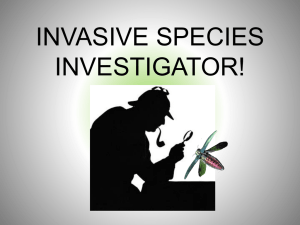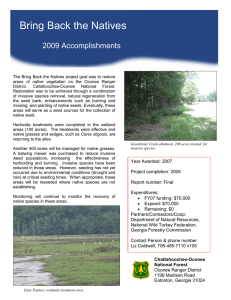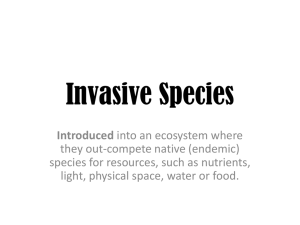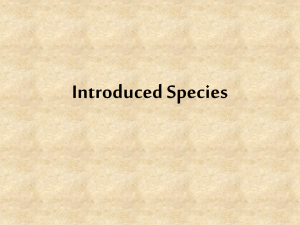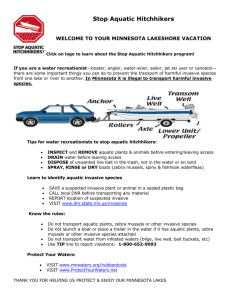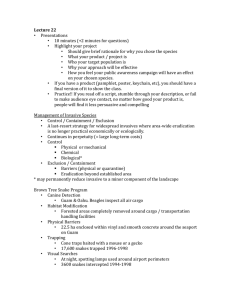Invasive Species
advertisement
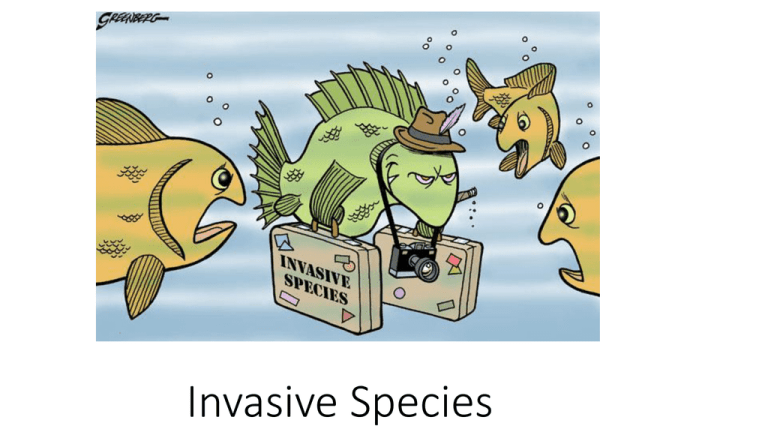
Invasive Species What are native species? Native species are those that normally live and thrive in a particular community. They occupy specific habitats and have specific niches in their native environment. They have natural predators that help to keep their populations in check. Buffalo Grass Scissor tailed Flycatcher Black Bear Definition • Invasive species-are plants, animals, or pathogens that are non-native to the ecosystem under consideration and whose introduction causes or is likely to cause harm. How did they get here? • Some introduced deliberately: • Some accidental: • naturalization societies • ballasts of ships • Shakespeare fans • unprocessed wood • game animals • fruit shipments • domestic animals • by-pass natural barriers What makes certain ecosystems more vulnerable? Diverse, undisturbed communities have few invaders Disturbed habitats: full of invaders Human residential areas: many European species that are commensal with humans Islands: little history with competitors, predators, parasites, or diseases Common characteristics of invasive species Invasive species in general: • Have few natural predators, competitors, parasites or diseases • Have high reproductive rates • Are long-lived • Are generalists • Are pioneer species Characteristics that make Zebra mussels a good invader include its ability to tolerate a widerange of environments, and high reproduction rate; female mussels release up to 100,000 eggs ability to tolerate a wide-range of environments year. Discussion: how would these characteristics enable a species to become invasive? What traits are common to invasive plant species Characteristics that make tree-of-heaven a good invader include its ability to flower early (within 2 years), ability to spread asexually, and fast growth rate. • Self-compatible • Flower early • Produces abundant seed • Disperse seed widely • Grow rapidly • Spread asexually • Strong competitors Impacts of invasive species Economic impacts: Invasive species are responsible for tremendous economic losses through loss in forest and agricultural productivity, spread of diseases that impact humans, among other impacts. European starlings, Sturnus vulgaris, spread diseases to wildlife, livestock, and humans, damage agricultural crops, and displace native birds. Their damage to agricultural crops is estimated at $800 million annually. European Starling •First successful introduction was 60 European starlings released in Central Park, NY. in 1890, by fans of Shakespeare –competes with bluebirds, woodpeckers Do we have any? • Zebra mussel • What: Mollusk • How: Caspian Sea region of Asia; accidentally released into Lake St. Clair in 1988 in ship ballast water • How Bad: Voracious filter feeders that out-compete native animals; fouls boats & clogs intake pipes at power plants and municipal water sources Do we have any? • Dutch Elm Disease • What: Fungus • How: Asia; one strain of the disease arrived in the 1930s in Cleveland, OH on infected elm logs from Europe; a more virulent strain arrived in 1940s • How Bad: Elms were once the nation’s most popular urban street tree, have now largely disappeared from both urban and forested landscapes. It is estimated that “Dutch” elm disease has killed over 100 million trees. Do we have any? • Fire Ant • What: Insect • How: South America; accidentally introduced to Alabama in 1930s • How Bad: Aggressive, multiple biter with painful venom and chance of allergy; may also damage fruits, berries and young crops; also damage electric boxes; ant mounds are a hazard to farm equipment. Do we have any? • Musk Thistle • What: Weed • How: Europe and Eurasia; Introduced to OK in 1944 possibly in contaminated seed • How Bad: Hardy weed that outcompetes native vegetation HUGE PROBLEMS • https://www.youtube.com/watch?v=rPeg1tbBt0A (Asian Carp) • https://www.youtube.com/watch?v=Gtqb41CjQfc (Zebra Mussels)


